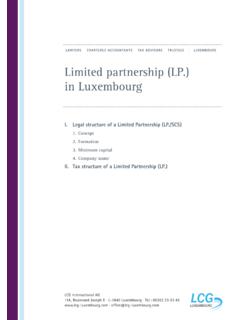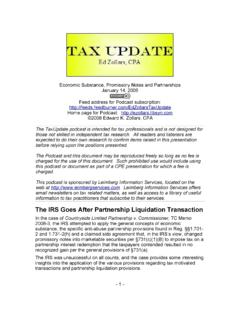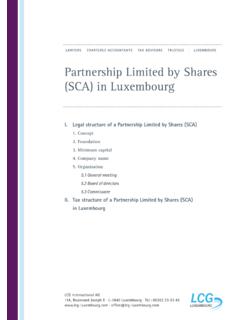Transcription of Master limied partnership accounting and …
1 Master limited partnership accounting and reporting guideFebruary 2017C| Master limited partnership accounting and reporting guide1 Master limited partnership accounting and reporting guide |Introduction1 What is an MLP?2 Preparing for formation of an MLP3 accounting and reporting by MLPs5 Predecessor financial information5 Carve-out financial statements8 Issuance costs9 accounting for contributed assets and liabilities10 accounting for an MLPs interests in partnerships and limited liability companies15 Convertible equity securities17 Puttable or redeemable equity securities17 Presentation of partnership equity accounts17 Allocating earnings between the GP and the LP19 Dividend policy disclosures21 accounting and reporting by sponsor entities of MLPs22 Consolidation considerations22 Noncontrolling interest presentation24 Issuance of equity by an MLP that does not result in loss of
2 Control by the sponsor entity26 Loss of control and deconsolidation considerations27 Goodwill impairment considerations29 Other matters31 Income tax-related matters31 SEC filing status and internal control over financial reporting following a spin-off32 Appendix33 Appendix A33 Appendix B37 Appendix C39 Contents1| Master limited partnership accounting and reporting guideIntroductionMaster limited partnerships (MLPs) have helped fuel growth and diversification in the oil and gas sector. Midstream pipeline operators have long dominated the energy MLP subsector, but other types of operations have also been put into MLP structures, including upstream exploration and production (E&P), drilling and other oil field services, gathering and processing, propane and refined product distribution, and coal production and shipping.
3 Companies have continued pursuing opportunities to take advantage of the MLP structure as the markets have been receptive to initial public offering (IPO) activity. From an accounting and reporting perspective, each MLP has its own set of complexities. No two MLPs are exactly alike. They each consist of a group of assets with their own unique history and set of issues, their own governance and their own legal with any business transaction, careful research and planning is essential. By giving early consideration to such complexities in the planning stages, companies can accelerate the MLP formation process, reduce costs and enhance the overall value of the MLP structure.
4 In this Master limited partnership accounting and reporting guide , we discuss a variety of common accounting and reporting considerations associated with the formation and ongoing operations of an MLP. The guide is designed to help companies understand the accounting and reporting issues associated with an MLP and the related authoritative guidance. However, it is not intended to be a substitute for detailed research or the exercise of professional judgment on all issues related to an MLP. We hope you find this publication limited partnership accounting and reporting guide |What is an MLP?An MLP is a limited partnership whose limited partnership units are available to investors and traded on public exchanges, just like corporate MLPs usually have (1) a general partner (GP), who typically holds a small percentage (commonly 1 2%) of the outstanding partnership units and manages the operations of the partnership and (2) limited partners (LPs), who provide capital and hold most of the ownership but have limited influence over the companies typically form MLPs for a variety of reasons, including, but not limited to, the ability to access public capital or to provide for a partial exit strategy for the MLP sponsor.
5 Additionally, MLPs may be formed to take advantage of the single-level of taxation that occurs as a result of the MLP being classified as a partnership for US federal income tax purposes. So long as the MLP meets the qualifying income requirements, MLPs do not pay US federal income taxes. Instead, each partner includes its distributive share of income, gain, loss, deduction, and credit when computing its US federal income tax. Distributions of cash from the MLP to the partners are not subject to US federal income tax at the time of distribution (although many MLPs withhold taxes on cash distributions with respect to non-US investors). This process often allows an MLP to avoid the double taxation generally applied to traditional corporations and their shareholders, resulting in higher cash flow and a lower cost of order for a publicly traded MLP to be treated as a partnership for US federal income tax purposes, at least 90% of an MLP s gross income must consist of qualifying income ( , income derived from certain natural resource related activities, as well as certain other activities).
6 2 As a result, the energy industry has experienced a dramatic rise in the use of the MLP structure over the last MLP structure typically allows the GP to make decisions on behalf of the MLP including its publicly traded common and subordinated interests (referred to collectively as LP interests or LP units throughout). The LPs ability to make decisions may be limited, even when a majority LP interest in the MLP is held by the public. This lets a sponsor entity take advantage of an MLP s potentially lower cost of capital while often retaining a controlling financial interest in the partnership s assets and operations. The MLP business model is built around generating and distributing cash flows on a quarterly basis.
7 Cash is generated and used to make debt payments, fund growth through acquisition of assets to generate additional cash, maintain the asset base and sustain the operating cash flow generating capability. The MLP s excess cash (which is defined in most MLP partnerships agreements as available cash ) is distributed to the GP and LPs in order to meet required minimum quarterly distributions. The GP (and, in limited circumstances, other investors) may separately hold incentive distribution rights (IDRs), that allow such investors to participate in cash distributions when the distribution to LPs exceeds certain levels. Holding IDRs encourages the GP to grow the MLP business and increase distributions to all formation, a typical MLP has four types of interests: (1) the GP interest (which is often held by the sponsor); (2) the IDR interest; (3) subordinated units (which earn a residual interest, are often held by the sponsor and are initially not publicly traded, although they may convert to common units as a result of meeting certain time or performance thresholds); and (4) common units (which may have a preferred return), which are sold (in whole or in part) to the public in connection with the The term MLP often encompasses both a traditional MLP and a variable MLP.
8 For purposes of this article, the term MLP references the traditional MLP format, which is often a limited partnership (with a general partner and limited partners) that provides for minimum quarterly distributions to holders of common units and often has incentive distribution rights (often held by the general partner). The variable MLP format is typically a limited liability company that is taxed as a partnership for US federal income tax purposes. As a general matter, the variable MLPs have neither incentive distribution rights nor minimum quarterly distributions, with one class of interests (at least upon formation). 2 At the time of this publication, in order to maintain treatment as a partnership , at least 90% of the MLP s gross income must consist of Qualifying Income, which is defined by the Internal Revenue Code | Master limited partnership accounting and reporting guideMLP structures are often focused on energy-related assets ( , pipelines, oil field service equipment, wells) with steady growth potential and high cash flow, which lend themselves to an MLP s objective of increasing cash distributions to unit holders.
9 Other subsets of the energy industry, such as natural gas processing plants, coal production facilities and fully developed and slowly declining crude oil or natural gas producing assets, have also utilized the MLP for formation of an MLPAs a plan to form a publicly traded MLP (also referred to as an MLP registrant) begins to materialize, identifying and addressing the accounting and reporting requirements becomes a key objective. Launching a publicly traded MLP can involve a considerable amount of organizational planning, technical research and an extensive process of collecting and preparing historical, and forecasted, financial information. The level of effort necessary to execute the plan should not be underestimated.
10 One of the early determinations that must be made is the form, content and level of any financial statements that the MLP would need to provide in a registration statement filed with the Securities and Exchange Commission (SEC). This may require obtaining audited financial statements for an entity or business for the first time. When an MLP registrant with minimal historical operations will succeed to the operations of another entity or group of entities, a predecessor must be identified for purposes of preparing historical financial statements. The historical financial statements of a predecessor may comprise financial statements of an existing entity or carve-out financial statements from a larger existing company.

















